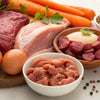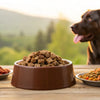How to Feed Frozen Raw Dog Food: A Comprehensive Guide for Pet Parents
- Houndsy
Table of Contents
- Introduction
- Understanding Frozen Raw Dog Food
- How to Transition to Frozen Raw Dog Food
- How to Prepare and Serve Frozen Raw Dog Food
- Best Practices for Safety and Hygiene
- Why Invest in Frozen Raw Dog Food?
- Conclusion
Introduction
Did you know that nearly 70% of dog owners are now gravitating towards raw diets to ensure optimal nutrition for their furry friends? As pet lovers, we constantly seek the best for our dogs, ensuring they lead healthy, vibrant lives. The shift toward feeding frozen raw dog food resonates deeply because it reflects a growing understanding of what our pets truly need—real, unprocessed ingredients that mirror their ancestral diet.
Feeding frozen raw dog food is not just a trend; it's a return to a more natural, nutritionally rich way of providing for our pets. In this guide, we will explore how to properly incorporate frozen raw dog food into your dog's diet, the benefits it offers, and key transitions to ensure your pet thrives on this dietary change.
By the end of this post, you will understand the nuances of feeding frozen raw food, from preparation and serving guidelines to the underlying health benefits it offers. If you've ever wondered how to make this shift seamlessly or if frozen raw food is right for your dog, we encourage you to reflect on your current feeding practices and how they can evolve to better serve your beloved pet.
Understanding Frozen Raw Dog Food
What is Frozen Raw Dog Food?
Frozen raw dog food consists of raw meat, organs, and bones, often supplemented with fruits and vegetables, all carefully formulated to provide balanced nutrition for dogs. Unlike traditional kibble, raw food retains all its natural nutrients and enzymes because it undergoes minimal processing, making it a more biologically appropriate choice for our canine companions.
Why Choose Frozen Raw Dog Food?
-
Nutritional Benefits:
- Raw diets typically boast higher protein content and fewer carbs compared to regular kibble, supporting muscle maintenance and energy levels.
- Frozen raw food is rich in natural vitamins and trace minerals, essential for overall health and vitality.
-
Digestive Health:
- Many dog owners report improvements in their pets' digestive health when transitioning to a raw diet. Raw food can lead to smaller, firmer stools due to its digestibility.
-
Enhanced Skin and Coat:
- The fat levels found in raw diets contribute to a shinier, healthier coat and may reduce skin allergies and dryness.
-
Behavioral Benefits:
- Dogs fed a raw diet often exhibit improved energy levels and behavior. The high protein content can fuel their natural instincts and support cognitive function.
What to Consider Before Feeding Frozen Raw Dog Food
Before making the transition to frozen raw dog food, several factors should be considered:
-
Quality of Ingredients: Choose high-quality products that use sustainable, ethically sourced ingredients. Look for brands that provide transparency in their sourcing and processing.
-
Dietary Needs: Assess your dog's specific health conditions and dietary needs. Consult with your veterinarian to determine if a raw diet is suitable for your pet.
-
Handling and Storage: Proper storage and handling are vital to ensure safety and quality. Always store raw food in the freezer until you're ready to use it, and follow safe thawing guidelines.
How to Transition to Frozen Raw Dog Food
The Importance of a Gradual Transition
Transitioning your dog to frozen raw dog food should be done thoughtfully to prevent digestive upset. A sudden change in diet can lead to gastrointestinal issues. A safe transition generally takes about 7-10 days:
-
Start Slow:
- Begin by replacing 25% of your dog’s current food with frozen raw dog food.
-
Adjust Gradually:
- Increase the proportion of raw food by about 25% every few days while decreasing the previous diet.
-
Monitor Your Dog:
- Keep an eye on your dog’s reactions during this period. Look for any signs of gastrointestinal distress, such as vomiting or diarrhea, and adjust accordingly.
Sample Transition Plan
| Day | Current Diet | Raw Diet |
|---|---|---|
| Day 1-2 | 75% | 25% |
| Day 3-4 | 50% | 50% |
| Day 5-6 | 25% | 75% |
| Day 7+ | 0% | 100% |
This gradual move helps your pet's digestive system acclimate to the new diet while reducing stress on their stomach.
How to Prepare and Serve Frozen Raw Dog Food
Thawing Guidelines
Proper thawing is crucial for maintaining the quality and safety of frozen raw dog food. Here are our recommendations for thawing:
-
Refrigerator Method:
- The safest method is to place the portion of frozen raw food in a covered container in the refrigerator. Depending on the size of the portion, this may take anywhere from 12-24 hours to fully thaw.
-
Room Temperature Method:
- For faster thawing, you can leave smaller portions at room temperature for 10-20 minutes.
-
Warm Water Bath:
- Place the frozen raw food in a sealed bag and submerge it in warm (not hot) water. This method allows for quick defrosting while preventing the food from reaching unsafe temperatures.
Serving Frozen Raw Dog Food
Once thawed, follow these serving tips:
-
Portion Control: Use a scale to measure your dog's food according to their weight and activity level. Most brands provide feeding guidelines on packaging, but adjustments may be needed for individual needs.
-
Using the Right Bowl: Always serve raw food in stainless steel or glass bowls, which are easy to clean. Avoid using plastic bowls, which can harbor bacteria even after washing.
-
Timing: Serve the food at mealtime and remove any uneaten portions after about two hours to prevent bacterial growth.
-
Hydration: Always ensure fresh water is available during and after mealtime. Some pet parents opt to add a little water or broth to the raw food to enhance palatability and hydration.
Best Practices for Safety and Hygiene
Handling raw dog food requires attention to hygiene to ensure safety for both pets and their humans. Here are key practices to keep in mind:
-
Cleanliness:
- Wash your hands before and after handling raw dog food. Use hot soapy water to clean any surfaces, bowls, and utensils that come into contact with raw food.
-
Storage:
- Keep frozen raw food sealed in its original packaging or in an airtight container in the freezer to maintain freshness.
-
Avoid Cross-Contamination:
- Keep raw dog food separate from human food. Store it in a designated area of the kitchen to prevent any cross-contact.
-
Dispose of Leftovers:
- Discard any uneaten raw food after two hours and never refreeze food that has already thawed.
-
Monitor Temperatures:
- When thawing frozen raw food, ensure it never exceeds room temperature for extended periods to reduce the risk of bacterial growth.
Why Invest in Frozen Raw Dog Food?
Investing in high-quality frozen raw dog food can significantly enhance your pet’s overall health and well-being. Not only does it provide them with an optimal nutrient profile, but it also aligns with our Houndsy commitment to elevating the dog-feeding experience through innovative design and reliability. Our flagship product, the Houndsy Kibble Dispenser, complements this journey by making feeding straightforward and aesthetically coordinated with your home decor. Discover how the Houndsy Kibble Dispenser can make your pet feeding ritual enjoyable by checking it out here.
Conclusion
As we’ve explored, feeding frozen raw dog food represents a fantastic opportunity to improve our pets’ nutrition and overall health. By transitioning gradually, following safe handling practices, and understanding your pet's individual needs, you unlock the potential joy and vibrancy that this diet can offer.
Feeding our pets shouldn't be just a task but a heartfelt commitment to their health and happiness. We invite you to take the plunge into the world of raw feeding and observe the incredible difference it can make. With practices in place and resources available, your journey as a raw feeder can be a rewarding one for both you and your beloved canine companion.
Frequently Asked Questions
Is frozen raw dog food better than kibble?
Generally, frozen raw dog food is considered more biologically appropriate for dogs as it closely resembles their natural diet, providing higher protein content and fewer fillers.
How much frozen raw food should I feed my dog?
Feeding guidelines vary based on your dog's age, weight, and activity level. Use the manufacturer's recommended serving size as a starting point and adjust according to your pet's individual needs.
Can my dog eat frozen raw food straight from the freezer?
No, raw dog food should always be thawed before serving to prevent choking and to allow for proper digestion.
How long can I keep leftover thawed raw food?
Once thawed, raw dog food should be consumed within 1-2 days if stored in the refrigerator.
Can I mix frozen raw food with kibble?
Yes, many pet owners choose to mix raw food with kibble. However, it's important to ensure that the raw food is properly thawed before mixing to avoid any digestive issues.
Explore how we can make your dog feeding experience more enjoyable with the Houndsy Kibble Dispenser and begin your journey towards better pet nutrition today! Order Now.












